The year 1930 was a brutal year for Alberta and all across North America.
The stock markets had crashed in October 1929. Many financial experts had initially predicted a short term blow to the economy. However, over the following months, the spiralling increases in unemployment indicated that things were going to get much worse.
Not only the economy went bad; even the weather turned bleak. There was a severe cold snap across the prairies on May 15th, 1930. On May 20th, a tremendous spring blizzard hit. There were high winds and a heavy dump of snow.
The wet snow in Central Alberta provided some benefits to the farmers with some badly-needed spring moisture.
Southeastern Alberta did not get the snow, but the high winds created enormous dust storms. It was the first indication of the terrible dust bowl conditions that would soon plague the prairies.
For most of the preceding decade, the United Farmers of Alberta had governed Alberta. In 1921, the U.F.A. had shocked the political world by plunging into direct electoral politics and winning the provincial election.
However, the U.F.A. had struggled through much of its first term.
The post-First World War depression was long and painful. Moreover, the government was inexperienced and often inept.
Nevertheless, the U.F.A. managed to win re-election in 1926.
A series of cooperative initiatives, most importantly the creation of the Alberta Wheat Pool, seemed to pay off for Alberta farmers. John Brownlee replaced Herbert Greenfield as premier and was more skilled at politics than Greenfield had been.
Moreover, the traditional Liberal and Conservative parties were still widely discredited after the upheavals of the First World War and subsequent post-war depression. Turning back to either of those parties was not an appealing alternative.
Late in 1929, Premier Brownlee secured the enormous political victory of negotiating the transfer of control over natural resources from the federal government to Alberta.
In normal times, that should have been enough to ensure a comfortable re-election. However, 1930 was anything but a normal year.
No one was prepared for the accelerating collapse of the economy. Brownlee organized an unemployment ‘summit’ with the mayors of Calgary and Edmonton.
However, the proposed solutions were limited to some public works projects and asking the federal government for a lot of money.
The election was finally called for June 19th. Brownlee quickly realized that re-election was going to be a much bigger challenge than he had thought just a few months before. The Liberals had just picked the popular former mayor of Fort MacLeod as their new leader. Although the Liberals were still scrambling to get organized, they started to show some surprising new strength, particularly in rural Alberta.
A new phenomenon also appeared. In many communities, people began to unite behind a particular candidate to defeat the government.
The MLA in Innisfail, Dr. G.C. Wagner was nominated as the Conservative candidate. However, a group of Conservatives joined the Liberals to back Dan Morkeberg as they thought he had a better chance of winning. In Lacombe, J.R. Mackie, the mayor of Alix, ran as the independent and sole candidate against Irene Parlby of the U.F.A.
At the end of May, Brownlee got a big break. Prime Minister Mackenzie King called a federal election.
The prospects of the Liberals and Conservatives uniting against the U.F.A. faded. However, a lot of momentum also went out of the provincial Conservative campaign. Resources were shifted to getting national Conservative leader R.B. Bennett of Calgary elected as the new prime minister.
The results on June 19th were a very mixed bag. The U.F.A. lost seats but still won the election. Although J.R. Mackie nearly won in Lacombe and the independents got only a few less votes than the Conservatives province-wide, only three of 29 independents managed to get elected.
The Liberals did much better than expected, but their leader, J.W. McDonald, was defeated in Macleod.
Nevertheless, the Depression continued to get worse. In the 1935 election, the U.F.A. was crushed by the new Social Credit party. Every single government MLA was defeated.



